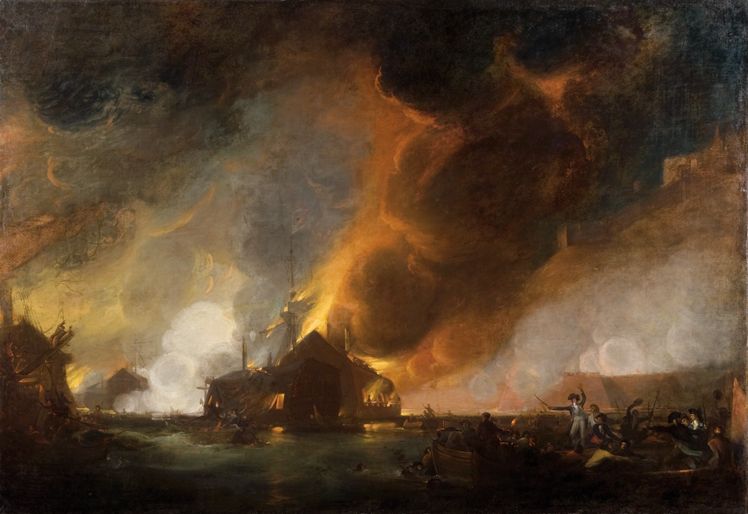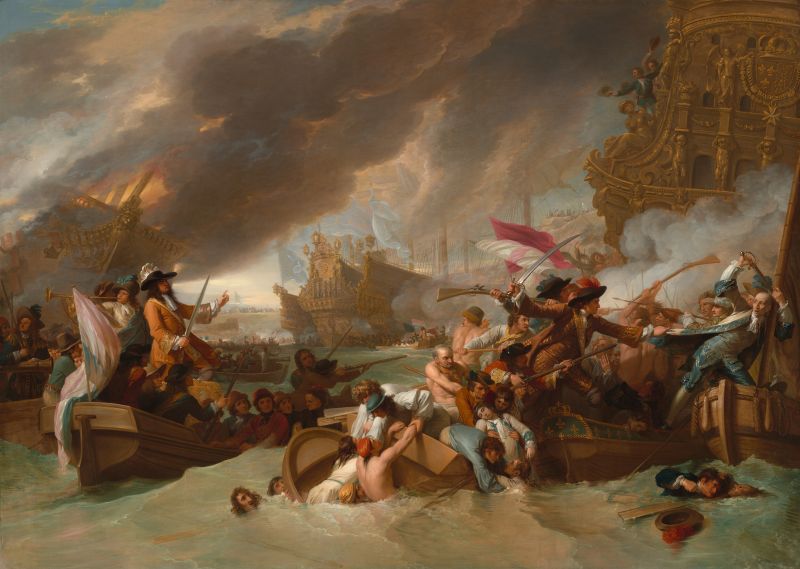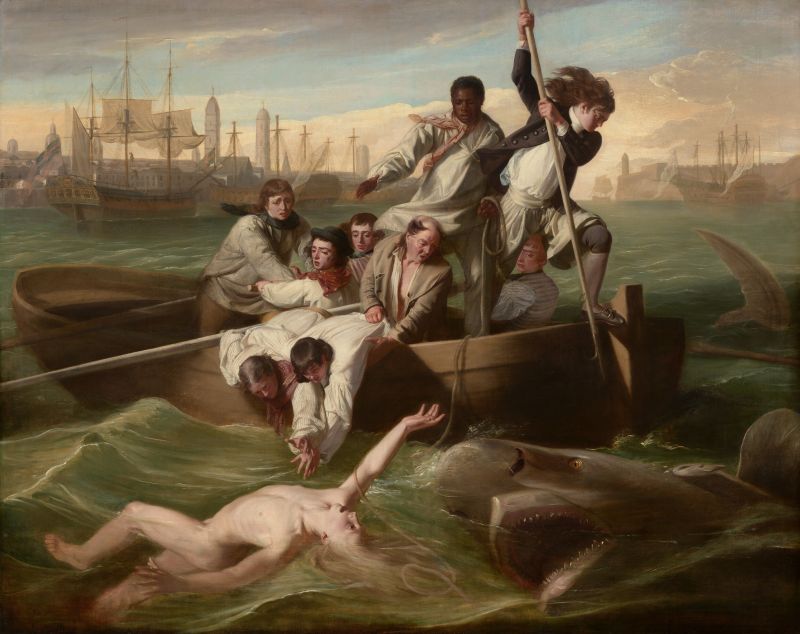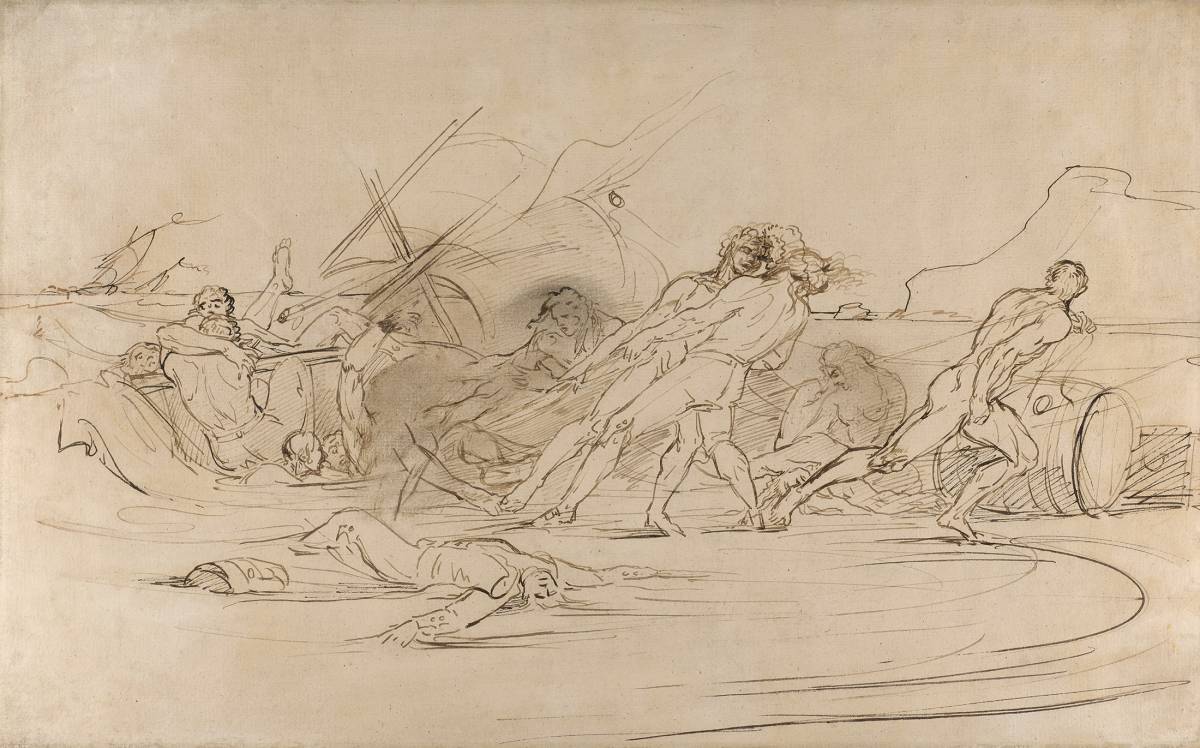This dynamic drawing shows a contemporary naval disaster, sailors are seen hauling in the wreck of a ship, whilst in the foreground is the body of a dead naval officer, identifiable by his costume. Made by Raphael Lamar West, the son of Benjamin West, who acted as his father’s principal assistant. West junior is not well known, but he was a bold and inventive draughtsman. This ambitious composition, known from two surviving studies, can be related to West senior’s interest in the Siege of Gibraltar, a defining British victory in the European theatre of the American Revolutionary War. In 1783 Raphael Lamar West showed one of his very rare oil paintings, Destruction of the Floating Batteries Before Gibraltar at the Royal Academy. The painting has long been confused with a work of the same title by Joseph Wright of Derby and is now in the collection of the Agnes Etherington Art Center in Kingston Ontario.[1]

Joseph Wright of Derby
A View of Gibraltar during the Destruction of the Spanish Floating Batteries,
on the 13th of September, 1782
Oil on canvas
63 ½ x 92 ⅝ inches; 1615 x 2354 mm
1784
Agnes Etherington Art Centre
West junior’s drawing shows a dramatic tableau of men hauling the wreck of a small boat onshore, whilst others cling to debris and the body of an officer is prominently floating in the foreground surf. The composition, known in two iterations, likely relates to the West workshops interest in contemporary military victories. In 1770 Benjamin West completed The Death of General Wolfe, the first in a sequence of celebrations of contemporary military victories. It was a formula adopted by West’s countryman and rival John Singleton Copley who completed Watson and the Shark in 1778 and Death of Major Peirson in 1784. Immediately after news of the British garrison at Gibraltar’s destruction of a combined French and Spanish flotilla of ‘floating batteries’, West and Copley were approached by the London Guildhall about the completion of ‘Historical Painting’ to commemorate the victory. West suggested two canvases, one showing the destruction of the flotilla and a second commemorating the arrival of the British fleet to relieve the British garrison a month later. Copley proposed a single monumental work combining both the destruction of the flotilla and the arrival of the relieving fleet. Copley won the commission and embarked upon a monumental work which would take him eight years to complete. In the meantime, West and his studio maintained an interest in the subject-matter. West urged his former pupil, John Trumbull to consider the victory, writing in 1786 that he considered it: ‘a subject of the History of this Country at once popular, sublime & in every respect perfect for the pencil.’[2] As Allen Staley has established Benjamin West made a schematic compositional study for the Destruction of the Floating Batteries Before Gibraltar now in the Morgan Library and museum, New York, that the seventeen year-old Raphael Lamar West used as the basis for a painting of the subject he exhibited at the Royal Academy in 1783.
The present energetic design develops figural types and compositional motifs found in West’s depiction of the Destruction of the Floating Batteries Before Gibraltar. Whilst not strictly preparatory, the sheet shows West’s interest in exploring the pathos of death at sea, in this case the wreck of a vessel breaking-up on the shore. As Allen Staley has discussed, Copley struggled with organising his giant canvas and relied on ideas, figures and motifs from West’s monumental The Battle of La Hogue which he completed in 1778. Painted to hang with The Death of General Wolfe, the scene shows a victorious British action in which a flotilla of small boats destroyed a large French fleet assembled to invade England in 1692. The unconventional composition essentially transposed the individual heroics of a land battle to sea. Copley employed the same idea in his Siege of Gibraltar, even borrowing figures from West’s painting. In the present drawing, West also quotes from his father’s painting; the two swimming men, with only their heads visible can also be found in the foreground of The Battle of La Hogue. West also borrows the sense of physical action, the sailors stripped to the waist pulling the wreck ashore; the sailors hauling their shipmates onto the wreck and the dead officer floating in the surf. This last detail suggests the young Raphael Lamar West was highly conscious of other contemporary maritime paintings, most notable Copley’s Watson and the Shark, the figure is posed in emulation of the stricken Watson, more pertinently, West may have been aware of Copley’s own staging of The Siege of Gibraltar in which a dead sailor, arms outstretched dominates the naval portion of the painting.

Benjamin West
The Battle of La Hogue, 1778
Oil on canvas
60 ⅛ x 84 ¼ inches; 1527 x 2140 mm
Courtesy National Gallery of Art, Washington

John Singleton Copley
Watson and the Shark, 1778
Oil on canvas
71 11/16 x 90 7/16 inches; 1821 x 2297 mm
Courtesy National Gallery of Art, Washington
Whilst the present design does not relate directly to West’s painting of the Destruction of the Floating Batteries Before Gibraltar, this ambitious drawing shows West was thinking about how to design a painting of a modern naval engagement. The actions, poses and general arrangement all point to West’s interest in continuing his father’s pioneering commemoration of modern military heroics, begun with the Death of General Wolfe. Only a limited body of drawings by Raphael Lamar West has been defined, but he was often a more ambitious and successful draughtsman and designer than his father. In this case, the complex tableaux features multiple figures in vigorous action. It was a design which evidently energised West as he produced a second treatment in red chalk which was sold by a descendant at Sotheby’s, 22 March 1979 and appeared again at Christie’s, 21 November 2007, lot 56.


